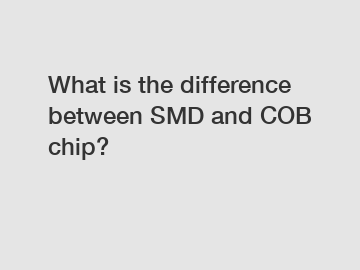What is the difference between SMD and COB chip?
What is the difference between SMD and COB chip?
In the world of LED technology, SMD (Surface Mount Device) and COB (Chip on Board) chips are two commonly used terms. These terms refer to different methods of packaging LED chips. Understanding the difference between SMD and COB chips is essential for anyone working in the lighting industry or considering purchasing LED lights. In this article, we will explore the characteristics, advantages, and disadvantages of each chip type.
SMD Chips - An Overview.

SMD chips are small, individual LED chips mounted onto a printed circuit board (PCB). These chips are typically rectangular in shape and come in various sizes, such as 2835, 3528, 5050, and 5630. SMD chips are widely used in various applications, ranging from LED panels and strips to light bulbs and displays.
Advantages of SMD Chips.
1. Size and Flexibility: SMD chips are small in size, allowing for compact and slim designs. Their compact nature makes them suitable for applications where space is limited, such as in mobile devices or slim light fixtures.
.
2. High Brightness: SMD chips can achieve high brightness levels, providing excellent illumination in lighting applications. The availability of different sizes and power options allows for customization and optimal brightness for different applications.
3. Efficiency: SMD chips are known for their energy efficiency. They consume less power while delivering bright light output, making them cost-effective and environmentally friendly.
Disadvantages of SMD Chips.
1. Heat Dissipation: SMD chips generate heat during operation, and without proper heat dissipation, their performance and lifespan may be affected. Adequate thermal management is essential to ensure the durability and effectiveness of SMD chips.
2. Glare: SMD chips, especially those with high brightness levels, can produce glare or unwanted reflections. This can be an issue in certain lighting installations or applications where harsh or concentrated lighting is not desirable.
COB Chips - An Overview.
COB chips are designed differently from SMD chips. Instead of individual chips mounted on a PCB, COB chips feature multiple LED chips directly mounted onto a substrate, forming a single module that acts as a light source. The substrate is often made of ceramic or metal and serves as a heat sink for efficient heat dissipation.
Advantages of COB Chips.
1. Heat Dissipation: The arrangement of multiple LED chips in close proximity allows COB chips to generate and dissipate heat more efficiently. This helps maintain the performance and longevity of the chips, making COB technology suitable for high-power applications.
2. Uniform Lighting: The close grouping of LED chips in COB chips ensures a more uniform light output. This eliminates the problem of individual hotspots or color inconsistencies that can occur with SMD chips.
3. Cost-Effectiveness: COB chips offer a cost-effective solution, as they require fewer components and manufacturing processes compared to SMD chips. This reduces production costs and makes COB chips a popular choice for budget-conscious consumers.
Disadvantages of COB Chips.
1. Size: COB chips are generally bulkier compared to SMD chips due to the multiple chips and the larger substrate. This may limit their use in applications where space constraints are a concern.
2. Limited Design Flexibility: The fixed arrangement of LED chips on COB modules may limit the customization options available. This can be a drawback in applications requiring specific light distribution or output.
In conclusion, both SMD and COB chips have their own advantages and disadvantages. The choice between them depends on the specific requirements of the application and the desired outcome. Whether it is the compact size and flexibility of SMD chips or the heat dissipation and uniform lighting of COB chips, considering these factors is crucial when selecting the right LED lighting solution.
For further information or inquiries regarding SMD and COB chips, please don't hesitate to contact us.
If you want to learn more, please visit our website what is a cree led light, led chip supplier, cree led chip types.
191
0
0

Comments
All Comments (0)